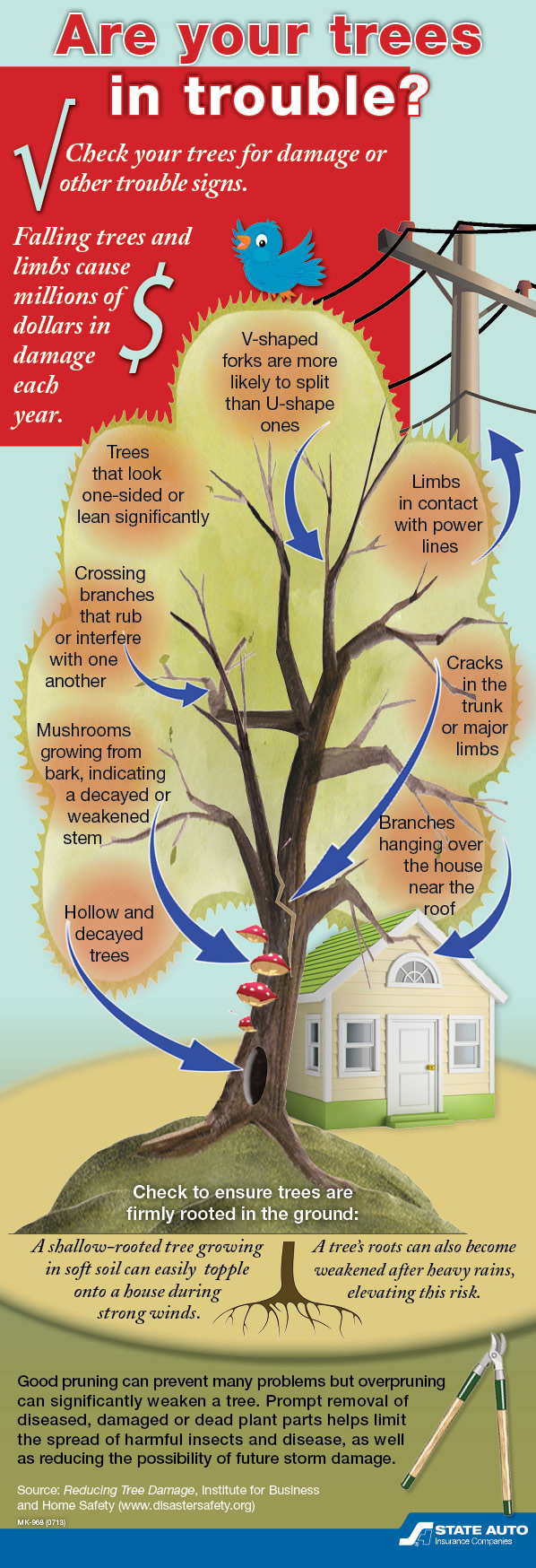It’s important to regularly examine trees and check for damage or other trouble signs. Good pruning can prevent many problems, but over-pruning can significantly weaken a tree.
Some trees are more prone to storm damage than others. A shallow-rooted tree growing in soft soil can easily topple onto a house during strong winds. A tree’s roots can also become weakened after heavy rains, elevating this risk. Check trees to ensure they’re firmly rooted in the ground.
These potential problems are easy to spot:
- Cracks in the trunk or major limbs.
- Hollow and decayed trees.
- Trees that look one-sided or lean significantly.
- Branches hanging over the house near the roof.
- Limbs in contact with power lines.
- Mushrooms growing from the bark, indicating a decayed or weakened stem.
- V-shaped forks rather than U-shaped ones.
- V-shaped are more likely to split.
- Crossing branches that rub or interfere with one another.
Good pruning can prevent many problems. Prompt removal of diseased, damaged or dead plant parts helps limit the spread of harmful insects and disease, as well as reducing the possibility of future storm damage.
Experts offer these pruning tips:
- Check local tree regulations prior to pruning or tree removal.
- Avoid pruning branches flush to the trunk. Doing so removes not only the limb but some of the trunk wood, opening the plant to possible decay or insect damage.
- Begin by making a cut partway through the bottom of any limb to be trimmed, a few inches from the trunk. Then cut through the limb just above the first cut. This ensures that when the limb falls, it will not tear off a long strip of bark on the way down.
- Finish by cutting off the few inches sticking out from the trunk. Be sure to leave the “branch collar,” the swollen area of trunk tissue that forms around the base of a branch. This protects the main trunk from damage.
Check out this video on Tree Care & Safety:
https://www.youtube.com/watch?v=Vza9fM77P7k
It’s also important to care for storm damaged trees. DisasterSafety.org recommends taking the following steps:
- In general, it is best to reset only smaller trees, since large trees will be weakened and may fall again.
- Decide what to do with tree stumps.
- If you are going to leave them, cut them off flush with the ground.
- If you plan to remove them, leave four feet of stump standing.
- Removal will be cheaper and easier if stumps can be pulled out instead of dug out.
- Cut weak branches that could easily be thrown against a structure during high winds. Also, reduce the chances of branches becoming weak by trimming branches more than five feet long.
Remove branches hanging over a structure.
- Contact the local utility company to trim away any limbs close to utility lines. It’s important to never touch a wire while trimming.
- Source: Institute for Business & Home Safety (IBHS) (www.disastersafety.org/)
